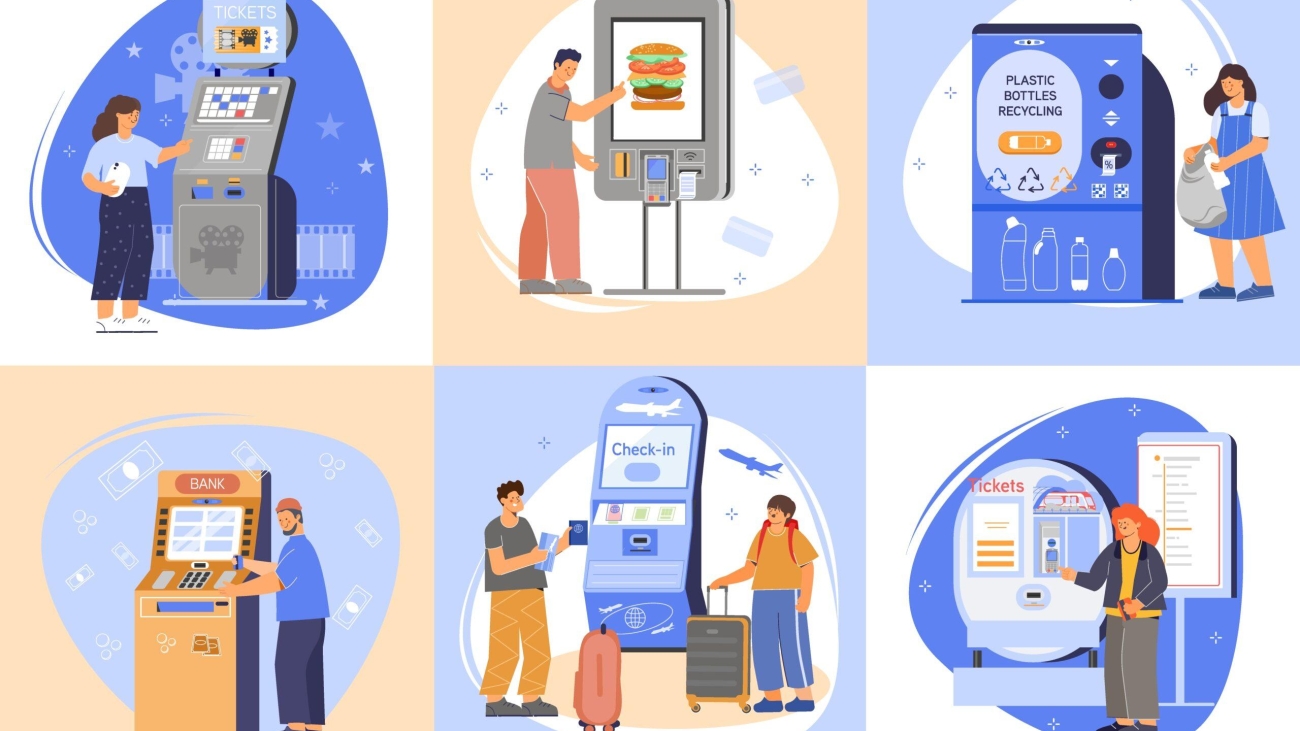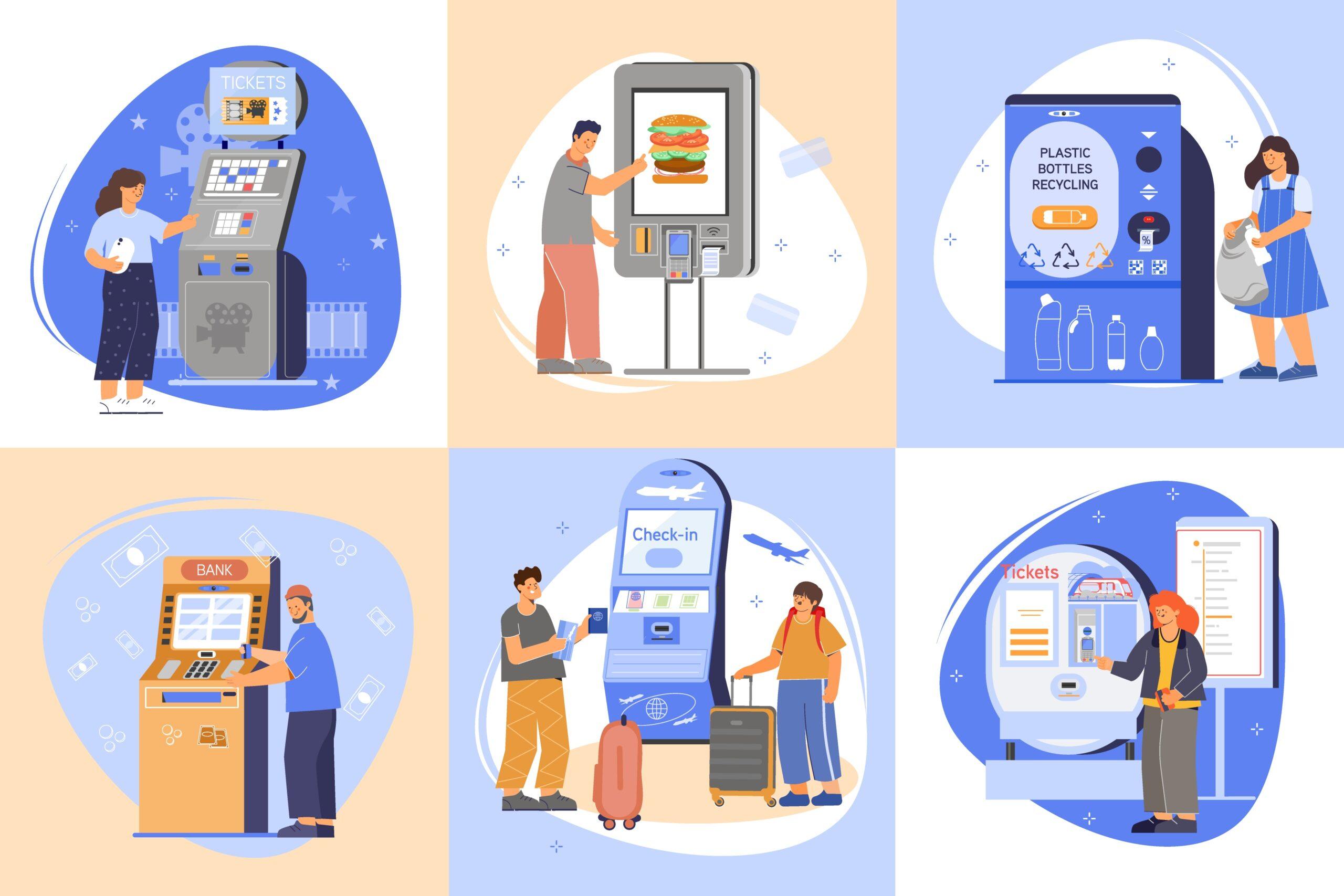
Self-Service Kiosks
- Digitos DM
- November 21, 2023
- 2 years ago
In the fast-paced world of dining, Quick Service Restaurants (QSRs) have always sought innovative ways to improve the customer experience. One technology that’s been making waves in the QSR industry is self-service kiosks. These interactive, touchscreen devices are changing the way we order and enjoy our favorite fast food. In this blog, we’ll explore how self-service kiosks are shaping the future of dining at QSRs and why they have become a game-changer in the foodservice industry.
History and Background:
Self-service kiosks within the realm of Quick Service Restaurants (QSRs) didn’t materialize out of thin air; their evolution is a fascinating journey marked by key milestones that have brought us to the widespread adoption we witness today. In this section, we will take a captivating dive into the historical roots and the progressive journey of self-service kiosks, as they steadily moved to claim their prominent role at the forefront of QSRs.
Early Experiments and Innovation:
Self-service kiosks, while now an integral part of QSR operations, had their humble beginnings as experimental innovations. They emerged as early experiments in streamlining the ordering process, aimed at reducing wait times and enhancing the customer experience. These early prototypes laid the foundation for a revolution in the QSR industry.
The Emergence of Touchscreen Technology:
A significant turning point in the development of self-service kiosks was the evolution of touchscreen technology. The introduction of user-friendly touchscreen interfaces made it possible for customers to interact directly with the kiosks, ushering in a new era of convenience and efficiency.
Key Milestones in Self-Service Kiosk Development:
- 1980s – The Birth of Self-Service: The concept of self-service kiosks was introduced in the 1980s, primarily as a way to expedite the order process and reduce human errors.
- 1990s – The Digital Revolution: With the rise of the internet and digital technology, self-service kiosks began to integrate more advanced features, such as online ordering and payment processing.
- Early 2000s – Widespread Adoption: The early 2000s saw the widespread adoption of self-service kiosks in the QSR industry, with major chains implementing them to enhance customer service.
- Present Day – Continuous Innovation: Today, self-service kiosks continue to evolve, incorporating cutting-edge technologies like artificial intelligence, mobile app integration, and contactless payment options.
From Niche to Mainstream:
What was once a niche concept has now become a mainstream reality. The journey of self-service kiosks from experimental innovation to widespread adoption signifies a transformation in how QSRs approach customer service and efficiency. It’s a journey that continues to evolve and adapt to meet the ever-changing needs and expectations of modern diners.
Benefits of Self-Service Kiosk:
The advantages of self-service kiosks extend far beyond shorter wait times. We’ll discuss how these kiosks enhance the dining experience, improve order accuracy, and empower customers to personalize their orders. Self-service kiosks aren’t just about efficiency; they are about giving diners more control and flexibility.
- Efficiency Redefined: Streamlined ordering with reduced wait times.
- Enhanced Order Accuracy: Minimized errors, ensuring accurate orders.
- Empowering Customer Personalization: Customizable orders to individual preferences.
- A World of Options: Detailed menu descriptions, nutritional information, and recommendations.
- Customer Empowerment and Flexibility: Control over the dining experience, at one’s own pace.
These benefits collectively elevate the dining experience, offering efficiency and a personalized journey for customers in Quick Service Restaurants (QSRs).
Challenges and Issues:
While self-service kiosks offer substantial benefits in Quick Service Restaurants (QSRs), they also come with their set of unique challenges and issues. In this section, we’ll delve into the common challenges associated with self-service kiosks and provide insights on how to effectively address and overcome them.
- Technical Reliability: Ensure consistent hardware and software performance for a smooth ordering process.
- Customer Familiarity: Acknowledge that some customers may not be accustomed to using self-service kiosks.
- Data Security: Safeguard customer data and payment information through encryption and security standards.
- User-Friendly Design: Address the potential for user errors with intuitive interfaces and confirmation prompts.
- Accessibility and Inclusivity: Ensure kiosks are accessible to all customers, including those with diverse needs.
- Regular Maintenance: Conduct ongoing maintenance to keep kiosks operating smoothly.
- Initial Investment: Recognize the upfront cost associated with implementing self-service kiosks.
- Integration Complexity: Seamlessly integrate kiosk technology with the existing QSR infrastructure.
- Staff Training: Prepare employees for evolving roles with comprehensive training programs.
- Ethical Practices: Consider ethical data use and customer privacy, including transparent data privacy policies.
How Self-Service Kiosk Works:
Ever curious about the inner workings of self-service kiosks? In this section, we’ll unravel the mechanics behind these user-friendly devices, providing a step-by-step guide on how customers can effortlessly use self-service kiosks to place their orders in Quick Service Restaurants (QSRs).
- Step 1. Welcome Screen: Customers are greeted with a friendly welcome screen as they approach the self-service kiosk. This screen typically displays the QSR’s branding and inviting visuals.
- Step 2. Language Selection: Customers can choose their preferred language from a menu, ensuring a comfortable ordering experience for diverse audiences.
- Step 3. Menu Exploration: The main menu appears, showcasing a tantalizing array of food and beverage options. Customers can navigate through different categories, such as burgers, salads, or beverages.
- Step 4. Item Selection: Customers select their desired items by tapping on the touchscreen. They can explore detailed descriptions and images of each menu item.
- Step 5. Customization: Many self-service kiosks allow for item customization. Customers can add or remove ingredients, choose portion sizes, or make special requests according to their preferences.
- Step 6. Special Requests: Customers can provide additional notes or special requests, like “extra cheese” or “no onions.”
- Step 7. Review Order: Before finalizing the order, customers have the opportunity to review their selections, ensuring accuracy.
- Step 8. Payment Options: Customers can choose their preferred payment method, which may include credit/debit card, cash, or mobile wallet payments.
- Step 9. Confirmation and Receipt: After payment, customers receive a digital receipt and an order confirmation. The receipt may include an order number for reference.
- Step 10. Kitchen Integration: The kiosk transmits the order directly to the kitchen, where the kitchen staff prepares the meal according to the customer’s specifications.
- Step 11. Order Ready: Customers can take a seat or wait in a designated area while their order is prepared. They are often alerted when their order is ready for pickup.
- Step 12. Enjoy Your Meal: Customers can savor their customized meals and enjoy a seamless dining experience with minimal wait times.
Self-service kiosks streamline the ordering process, empower customers to customize their orders, and ensure efficient kitchen operations. This technology has become an integral part of the modern QSR experience, providing convenience, accuracy, and a personalized touch to dining out.
Types and Variations:
In the world of self-service kiosks, diversity reigns supreme. Not all kiosks are created equal, and there’s a wide array of types and variations to choose from, each offering its unique set of features and benefits. In this section, we’ll explore the different options and evaluate the pros and cons of each.
1. Standard Self-Service Kiosks:
- Pros:
- These kiosks are widely available and cost-effective.
- They offer basic functionality for order placement and payment.
- Cons:
- Limited customization and advanced features compared to other types.
2. Tablet-Based Kiosks:
- Pros:
- Compact and versatile, often using tablets or iPads.
- Highly portable and can be used at tables or within the establishment.
- Cons:
- May have a smaller screen and limited space for menu options.
3. Mobile App Integration:
- Pros:
- Customers can use their smartphones to access the QSR’s app for self-service.
- Offers a familiar and convenient ordering experience.
- Cons:
- Requires customers to download and install the app.
4. Interactive Touchscreen Tables:
- Pros:
- Tables with built-in touchscreens for ordering.
- Ideal for dining in restaurants, allowing customers to place orders directly at their table.
- Cons:
- Higher implementation costs and maintenance.
5. Outdoor and Drive-Thru Kiosks:
- Pros:
- Designed for use in drive-thru lanes or outdoor settings.
- Speeds up order placement for customers on the go.
- Cons:
- Exposure to various weather conditions may require rugged construction.
6. Custom Kiosks with AI Integration:
- Pros:
- Custom-built kiosks with advanced artificial intelligence (AI) features.
- Highly tailored to a specific QSR’s needs and can offer predictive ordering, recommendations, and loyalty program integration.
- Cons:
- Higher initial costs and more extensive development.
7. Dual-Language Kiosks:
- Pros:
- Designed for multilingual customer bases.
- Offer language selection options to cater to diverse audiences.
- Cons:
- May require additional software development for language support.
8. Contactless Payment Kiosks:
- Pros:
- Emphasize contactless payment options for enhanced safety.
- Ideal for QSRs looking to minimize physical contact during the ordering and payment process.
- Cons:
- May require additional hardware and software integration.
9. Drive-Thru Speaker Kiosks:
- Pros:
- Combined with traditional drive-thru speakers.
- Enhance customer interaction and order accuracy.
- Cons:
- May necessitate complex integration and staff training.
The choice of self-service kiosk type depends on the specific needs, preferences, and budget of a Quick Service Restaurant (QSR). Whether opting for standard kiosks for basic functionality or investing in custom kiosks with advanced AI features, each variation aims to streamline the ordering process and enhance the customer experience in its unique way.
Tips and Best Practices for Self-Service Kiosks:
To fully harness the potential of self-service kiosks, it’s essential for both customers and Quick Service Restaurant (QSR) operators to understand the best practices. These tips and best practices ensure a seamless experience and maximize the benefits of self-service kiosks in the QSR environment. Here’s what you need to know:
For Customers:
- Familiarize Yourself: Take a moment to get acquainted with the kiosk’s interface. It’s user-friendly, but knowing the basics will streamline your ordering process.
- Browse the Menu: Explore the menu categories and options. Self-service kiosks often provide vivid images and detailed descriptions of items, making it easier to make choices.
- Customize Your Order: Don’t hesitate to customize your order according to your preferences. Add or remove ingredients, select portion sizes, and make special requests to tailor your meal.
- Double-Check Your Order: Before finalizing your order, review your selections. Ensure you’ve chosen the right items and made the desired customizations.
- Use Contactless Payment: If available, opt for contactless payment methods for added safety and convenience. It’s a quick and secure way to settle your bill.
For QSR Operators:
- Regular Maintenance: Schedule routine maintenance to ensure kiosks operate smoothly. Regular updates and hardware checks are crucial.
- User-Friendly Design: Invest in an intuitive and user-friendly interface for your kiosks. Clear instructions and prompts reduce errors.
- Accessibility and Inclusivity: Ensure your kiosks are accessible to all customers. Incorporate features like voice assistance and adjustable touchscreen settings for inclusivity.
- Staff Training: Provide comprehensive training programs for your staff to assist customers with kiosk usage. Knowledgeable staff can ease the transition for customers who may be less tech-savvy.
- Data Security: Implement robust data security measures to safeguard customer information. Encrypt data, adhere to security standards, and conduct regular security audits.
- Ethical Data Use: Be transparent about data privacy policies and compliance with relevant regulations. Customers trust you with their data; honor that trust.
- Customer Feedback: Encourage customers to provide feedback on their kiosk experience. Use this input to make improvements and adjustments as needed.
By following these tips and best practices, both customers and QSR operators can make the most of self-service kiosks. Customers enjoy a convenient and personalized dining experience, while operators benefit from improved efficiency and customer satisfaction.
Conclusion:
In summary, self-service kiosks have emerged as an indispensable element of the Quick Service Restaurant (QSR) industry, revolutionizing the way we dine. These kiosks bring a compelling combination of convenience and customization to the table, enhancing the overall dining experience. As technology continues its relentless march forward, self-service kiosks are poised to play an even more pivotal role in shaping the future of dining at QSRs.
The journey of self-service kiosks has only just begun, and the horizons are brimming with possibilities for both QSR operators and diners. As these innovative devices continue to evolve, they are set to offer an ever more efficient, personalized, and technologically advanced dining experience. With a focus on efficiency, customization, and responsiveness to the changing demands of modern consumers, self-service kiosks are here to stay, ensuring that the future of dining at QSRs is brighter than ever.




















